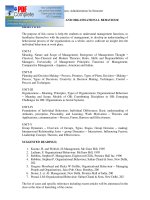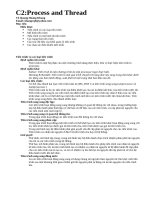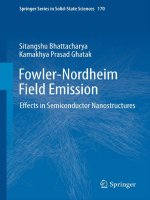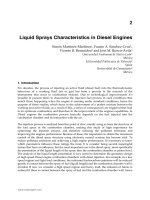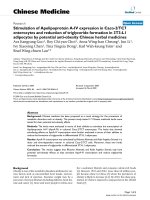Combustion process and emission formation in diesel engines fuelled by biofuels and blend fuels
Bạn đang xem bản rút gọn của tài liệu. Xem và tải ngay bản đầy đủ của tài liệu tại đây (9.66 MB, 224 trang )
COMBUSTION PROCESS AND EMISSION
FORMATION IN DIESEL ENGINES FUELLED BY
BIOFUELS AND BLEND FUELS
AN HUI
(B.Eng.(Hons.)), NUS
A THESIS SUBMITTED
FOR THE DEGREE OF DOCTOR OF
PHILOSOPHY
DEPARTMENT OF MECHANICAL ENGINEERING
NATIONAL UNIVERSITY OF SINGAPORE
2013
i
DECLARATION
I hereby declare that the thesis is my original work and it has been written by
me in its entirety. I have duly acknowledged all the sources of information
which have been used in the thesis.
This thesis has also not been submitted for any degree in any university
previously.
An Hui
23 July 2013
ii
ACKNOWLEDGEMENTS
I would like to express my sincere gratitude and appreciation to my
supervisors Prof Chou Siaw Kiang, Dr. Chua Kian Jon, Ernest and Dr. Yang
Wenming for seeing my potential and giving me this opportunity to be part of
the engine research team. In particular, I would like to thank them for their
insightful guidance, valuable feedbacks, patience and encouragement during
the course of my Ph.D. programme. Without them, this work would not have
been possible.
Furthermore, I would like to express my special thanks and gratitude to Dr.
Valeri Golovitchev (Associate Professor, Chalmers University of Technology)
for his continuous guidance and advice via email communication and during
his visit to NUS. Additional thanks go to Dr. Randy P. Hessel (Senior Scientist,
ERC University of Wisconsin) for his much help on the learning of KIVA4
code, and Dr. Chin Jen Sung (Professor, The University of Connecticut) for
sharing with me the DRGEPSA code.
Thanks to all the technical staff of EBTS group, particularly Mr. Tan Tiong
Thiam, and Mrs. Hung-Ang Yan Leng for their kind help and cooperation.
And thanks to all the members of Prof Chou, Dr. Chua and Dr. Yang’s
research teams: Mr. Nian Jialiang Victor, Mr. Zhao Xing, Mr. Vedharaj
Sivasankaralingam, Mr. Vallinayagam Raman, Mr. Balaji Mohan, Mr. Jiang
Dongyue, Mr. Cui Xin, Mr. Amin Maghbouli, Ms. Aqdas Nida, Ms. Li Jing,
Ms. Ge Mengyi, Mr. Xu Jia, for their constant support. Special appreciation
goes to Mr. Amin Maghbouli for his continuous help, insightful suggestions
and his invaluable time to share with me to discuss the technical results, which
have been greatly helpful in the advancement of my research.
Last but not least, I would like to express my utmost thanks to my mother,
father and sister for their understanding, support and encouragement
throughout these years. Finally, heartfelt thanks go to my beloved wife Ning
Ning for all her love, support, accompany and encouragement when most of
my time was devoted into the simulation and thesis writing even during
weekends and holidays. You are my favorite everything.
iii
TABLE OF CONTENTS
ACKNOWLEDGEMENTS ii
TABLE OF CONTENTS iii
SUMMARY vi
LIST OF TABLES viii
LIST OF FIGURES x
LIST OF PUBLICATIONS xiv
LIST OF SYMBOLS xvi
Chapter 1 Introduction 1
1.1 Background and Motivations 1
1.2 Objectives and Approach 5
1.3 Outline of Thesis 6
Chapter 2 Biodiesel Chemical and Thermo-Physical Properties 7
2.1 Introduction 7
2.2 Physical Properties Prediction Models 9
2.2.1 Normal Boiling Point 9
2.2.2 Critical Properties 11
2.2.3 Vapor Pressure 12
2.2.4 Latent Heat of Vaporization 13
2.2.5 Liquid Density 14
2.2.6 Liquid Viscosity 15
2.2.7 Liquid Thermal Conductivity 16
2.2.8 Gas Diffusion Coefficients 17
2.2.9 Surface Tension 17
2.3 Estimated Results 18
2.4 Application of Mixing Rules 30
2.5 A New Generalized Correlation for Accurate Vapor Pressure Prediction
30
2.5.1 Comparison of Various Vapor Pressure Prediction Models 31
2.5.2 A New Prediction Method 35
2.5.3 Model Validation 36
2.6 Conclusions 40
Chapter 3 Development of Skeletal Biodiesel Reaction Mechanism 42
3.1 Introduction 42
3.2 Mechanism Reduction Methodology on DRGEPSA Method 44
3.3 Skeletal Biodiesel Reaction Mechanism Generation 47
iv
3.3.1 Directed Relation Graph with Error Propagation and Sensitivity
Analysis 48
3.3.2 Integration of Soot Formation Mechanism 49
3.3.3 Peak Concentration Analysis 52
3.3.4 Isomer Lumping 55
3.3.5 Unimportant Reactions Elimination 56
3.3.6 Reaction Rate Adjustment 57
3.4 Emission Models 58
3.4.1 Nitrogen Oxide Formation Mechanism 58
3.4.2 Soot Formation Mechanism 59
3.5 Mechanism Validation 60
3.5.1 0-D Ignition Delay Validation 60
3.5.2 3-D Validations in a Compression Ignition Diesel Engine 63
3.7 Conclusions 65
Chapter 4 Theoretical Modeling of Biodiesel Combustion 67
4.1 Gas Phase Modeling 67
4.1.1 Governing Equations 68
4.1.2 Turbulence Equations 70
4.2 Spray Modeling 71
4.2.1 Spray Equations 72
4.2.2 Droplet Kinematics 73
4.2.3 Drag Force 73
4.2.4 Breakup Model 74
4.2.5 Collision Modeling 77
4.3 Combustion Modeling 79
4.3.1 Reaction Kinetics 80
4.3.2 Coupling of KIVA4 and CHEMKIN II 81
Chapter 5 Combustion and Emission Characteristics of Diesel Engine Fueled
by Biodiesel at Partial Load Conditions 83
5.1 Introduction 83
5.2 Biodiesel Combustion in a Light Duty Diesel Engine 86
5.2.1 Experimental Set-up and Procedures 86
5.2.2 Performance, Combustion and Emission Characteristics 88
5.3 Biodiesel Combustion Simulations 105
5.3.1 Numerical Approaches 105
5.3.2 Modeling validation and the effects of biodiesel blend ratio on the
engine emission characteristics 108
v
5.3.3 Three Dimensional Investigation on the Emission Characteristics
111
5.4 Conclusions 116
Chapter 6 Hydrogen Assisted Diesel/Biodiesel Combustion in a Diesel Engine
119
6.1 Introduction 119
6.2 Hydrogen Assisted Diesel Combustion 122
6.2.1 Numerical Modeling 122
6.2.2 Model Validation 124
6.2.3 Combustion and Emission Characteristics 124
6.3 Hydrogen Assisted Biodiesel Combustion 136
6.3.1 Numerical Modeling 136
6.3.2 Model Validation 138
6.3.3 Combustion and Emission Characteristics 141
6.4 Conclusions 152
Chapter 7 Conclusions and Recommendations 154
7.1 Conclusions 154
7.1.1 Biodiesel combustion model development 154
7.1.2. Combustion and emission characteristics of biodiesel fueled diesel
engine 155
7.2.3 Hydrogen assisted biodiesel combustion 156
7.2 Recommendations for Future Work 156
7.2.1 Improvement on biodiesel combustion chemistry 156
7.2.2 Application of new combustion strategies 157
Bibliography 158
Appendices 169
vi
SUMMARY
The International Energy Agency World Energy Outlook highlights the
increasing importance of alternative fuels in meeting the energy demand while
achieving minimum environmental impacts. Among the various alternative
fuels being developed, biodiesel has a great potential to replace conventional
diesel resulting in reduced harmful emissions. Unlike conventional diesel,
which is dominated by saturated hydrocarbons, the major components of
biodiesel are the fatty acid methyl esters having long carbon chains. With the
differences in their molecular structures, the combustion and emission
characteristics of biodiesel differ from those of conventional diesel. Therefore,
to better utilize biodiesel in modern diesel engines, efforts will have to be
made to better understand the potential and limitations of biodiesel. This
dissertation describes the work carried out on (i) the development of a skeletal
biodiesel combustion model for multi-dimensional simulations; (ii) theoretical
and experimental investigations on the combustion and emission
characteristics of a diesel engine fueled by biodiesel; and (iii) a feasibility
study on hydrogen assisted biodiesel combustion strategy for an improved
performance with reduced emissions.
First, a skeletal reaction mechanism consisting of 112 species and 498
reactions with CO, NO
x
and soot formation kinetics embedded was developed
to simulate the combustion process of diesel, biodiesel and their blend fuels.
Extensive validations were performed for the developed reaction mechanism
and the results indicated that the predicted ignition delay timings of n-heptane
and biodiesel agreed very well with experimental data. The reaction model
was further integrated into a 3-D engine simulation software, KIVA4, to
predict the performance of the engine with high accuracy. For a better
representation of biodiesel fuel properties, a detailed physical properties
predictive model was developed for the five typical methyl esters of biodiesel
and was integrated into the KIVA4 fuel library.
Second, experimental and numerical studies were conducted on a light duty
diesel engine to investigate the impact of biodiesel on the engine’s
performance, combustion and emission characteristics. Simulations were
vii
carried out using the coupled KIVA-CHEMKIN code, and simulated cases
were validated against experimental results by comparing the in-cylinder
pressure and heat release rate. Key results revealed that one major drawback
associated with biodiesel combustion was the reduced power output with
higher CO emissions at partial load conditions due to the increased viscosity
of biodiesel.
Finally, a detailed chemical reaction model was developed to investigate
the impact of supplemental hydrogen induction on biodiesel combustion.
Simulation results indicated that with the increase of hydrogen induction rate,
a substantial increase in the peak cylinder pressure and heat release rate could
be obtained under 50% and 100% load conditions, although a slightly reduced
performance was observed at 10% load conditions. In addition, a decreasing
trend was observed for both CO and soot emissions under all engine speed and
load conditions. Generally, it can be concluded that hydrogen assisted dual
fuel combustion strategy can be applied to improve significantly the
combustion process of biodiesel with reduced emissions.
viii
LIST OF TABLES
Table 2.1 Chemical compositions of palm oil biodiesel by GC analysis 7
Table 2.2 Basic properties of NO.2 diesel and palm oil biodiesel 8
Table 2.3 Five typical methyl esters of biodiesel 10
Table 2.4 The normal boiling points of pure methyl esters 18
Table 2.5 Predicted critical properties 19
Table 2.6 Predicted vapor pressure 21
Table 2.7 Latent heat of vaporization at the normal boiling point for methyl
oleate 23
Table 2.8 Reference densities of the five methyl esters 23
Table 2.9 Predicted liquid density 24
Table 2.10 Calculated constant values for liquid viscosity prediction 26
Table 2.11 Predicted liquid thermal conductivity 27
Table 2.12 Predicted gas diffusion coefficients 28
Table 2.13 Predicted surface tension 29
Table 2.14 Average absolute percentage deviation for each compound 37
Table 3.1 Ignition delay validation for n-heptane after mechanism combination
50
Table 3.2 Ignition delay validation for n-heptane after peak concentration
analysis 53
Table 3.3 Lumped isomer groups for n-heptane and biodiesel 56
Table 3.4 Adjusted pre-exponential factors for optimized ignition delay
predictions (in bold) 58
Table 3.5 Elementary reactions in the thermo NO mechanism 59
Table 3.6 Ignition delay validation for n-heptane for the final reaction
mechanism 61
Table 4.1 Constants used in the conventional and RNG k epsilon models 71
Table 5.1 Engine specifications 87
Table 5.2 Specifications of measurement devices 89
ix
Table 5.3 Fuel properties 89
Table 5.4 λ values for B100 93
x
LIST OF FIGURES
Figure 2.1 The comparison of vapor pressure prediction methods for methyl
oleate 20
Figure 2.2 The comparison of vapor pressure before and after the conversion
for C16:0 21
Figure 2.3 The comparison of latent heat of vaporization prediction methods
for methyl oleate 22
Figure 2.4 The verification of liquid density prediction method for methyl
oleate 24
Figure 2.5 The comparison of liquid viscosity prediction methods for methyl
oleate 25
Figure 2.6 The comparison of liquid thermal conductivity prediction methods
for methyl oleate 26
Figure 2.7 The comparison of liquid thermal conductivity before and after the
conversion for C16:0 27
Figure 2.8 The verification of gas diffusion coefficients prediction method for
methyl oleate 28
Figure 2.9 The comparison of surface tension prediction methods for methyl
oleate 29
Figure 2.10 The comparison of vapor pressure data of Isovaleric acid
(C
5
H
10
O
2
) calculated using different methods 34
Figure 2.11 The comparison of vapor pressure data of n-Heptadecane (C
17
H
36
)
calculated using different methods 35
Figure 2.12 Validation of the modified Lee-Kesler’s method for Ethanol
(C
2
H
6
O) 38
Figure 2.13 Validation of the modified Lee-Kesler’s method for Isovaleric
Acid (C
5
H
10
O
2
) 38
Figure 2.14 Validation of the modified Lee-Kesler’s method for n-Heptane
(C
7
H
16
) 39
Figure 2.15 Validation of the modified Lee-Kesler’s method for n-Tetradecane
(C
14
H
30
) 39
Figure 2.16 Validation of the modified Lee-Kesler’s method for n-
Heptadecane (C
17
H
36
) 40
Figure 3.1 Directed relation graph mapping 45
xi
Figure 3.2 Overview of the mechanism reduction process 48
Figure 3.3 Comparisons of ignition delay predictions between the reduced
mechanism with the detailed mechanism for biodiesel after mechanism
combination at an equivalent ratio of a) 0.5, b) 1.0 and c) 2.0 52
Figure 3.4 Comparisons of ignition delay predictions between the reduced
mechanism with the detailed mechanism for biodiesel after peak concentration
analysis at an equivalent ratio of a) 0.5, b) 1.0 and c) 2.0 55
Figure 3.5 Ignition delay validation for biodiesel at an equivalent ratio of a)
0.5, b) 1.0 and c) 2.0 63
Figure 3.6 3-D validation of biodiesel combustion at 2400 rpm and a) 10%, b)
50% and c) 100% loads 65
Figure 4.1 Droplet distortion model 75
Figure 4.2 Flow chart of integrated KIVA-CHEMKIN code 82
Figure 5.1 Schematic diagram of the engine test bed 87
Figure 5.2 Variation of engine torque at full load conditions for tested fuels . 90
Figure 5.3 Variation of BSFC at a) 100% load and b) 10% load for tested fuels
92
Figure 5.4 Variation of BTE at a) 100% load, b) 50% load and c) 10% load for
tested fuels 95
Figure 5.5 Variation of exhaust temperature at 100% load for tested fuels 96
Figure 5.6 Cylinder pressure curves at a) 10% load, b) 50% load and c) 100%
load 97
Figure 5.7 Heat release rate curves at a) 10% load, b) 50% load and c) 100%
load 98
Figure 5.8 Carbon monoxide (CO) emission at a) 10% load and b) 100% load
for all tested fuel 100
Figure 5.9 Carbon monoxide (CO) emission at various engine loads and 2400
rpm 101
Figure 5.10 Carbon dioxide (CO
2
) emission at 100% load 102
Figure 5.11 Hydro-carbon (HC) emission at 100% load 102
Figure 5.12 Nitrogen oxides (NO
x
) emission at a) 10% load, b) 50% load and c)
100% load 104
Figure 5.13 Nitrogen oxides (NO
x
) emission at various engine loads and 2400
rpm 105
xii
Figure 5.14 The a) medium and b) fine 60 degrees sector mesh shown at top
dead center 107
Figure 5.15 Cylinder pressure comparison at 1200 RPM and 100% load 108
Figure 5.16 Model validations for in-cylinder pressure histories and heat
release rate 109
Figure 5.17 Model validation for emissions 111
Figure 5.18 Temporal development of CO emissions at 10% load 112
Figure 5.19 Spatial and temporal plot of the in-cylinder CO mole fractions at 5°
ATDC, 20° ATDC and 40° ATDC 113
Figure 5.20 Spatial plots of the in-cylinder a) gas temperature distribution, and
b) NO mole fractions at 30° ATDC 115
Figure 6.1 Validation of simulation results of diesel combustion without H2
induction 125
Figure 6.2 Effect of hydrogen induction on the indicated thermal efficiency at
a) 1600 rpm, b) 2400 rpm and c) 3200 rpm 127
Figure 6.3 Effect of hydrogen induction on the cylinder pressure 129
Figure 6.4 Heat release rate at a) 10% load 1600 rpm, b) 10% load 3200 rpm
and c) 100% load 1600 rpm 130
Figure 6.5 Effect of hydrogen induction on the carbon monoxide emission at a)
1600 rpm, b) 2400 rpm and c) 3200 rpm 132
Figure 6.6 Effect of hydrogen induction on the nitrogen oxides emission at a)
1600 rpm, b) 2400 rpm and c) 3200 rpm 134
Figure 6.7 Effect of hydrogen induction on the soot emission at a) 1600 rpm, b)
2400 rpm and c) 3200 rpm 136
Figure 6.8 Comparisons of ignition delay predictions between the skeletal
mechanism and the detailed mechanism at an equivalent ratio of a) 0.5, b) 1.0
and c) 2.0 139
Figure 6.9 Validation of simulation results of biodiesel combustion with H
2
induction 140
Figure 6.10 Cylinder pressure comparison of biodiesel combustion with an
without hydrogen induction 142
Figure 6.11 Heat release rate comparisons at a) 10% load 2400 rpm, b) 50%
load 2400 rpm and c) 100% load 2400 rpm 144
xiii
Figure 6.12 Effect of hydrogen induction on the carbon monoxide emissions at
a) 2400 rpm and b) 3200 rpm 145
Figure 6.13 Spatial and temporal plot of the in-cylinder CO mole fractions at 5°
ATDC, 20° ATDC and 40° ATDC 146
Figure 6.14 Effect of hydrogen induction on the nitrogen oxides emissions at a)
2400 rpm and b) 3200 rpm 148
Figure 6.15 Spatial plots of the in-cylinder gas temperature distribution and
NO mole fractions at 20° ATDC 149
Figure 6.16 Effect of hydrogen induction on the exhaust emissions of soot at a)
2400 rpm and b) 3200 rpm 150
Figure 6.17 Spatial and temporal plot of the in-cylinder soot mole fractions at
5° ATDC, 20° ATDC and 40° ATDC 151
xiv
LIST OF PUBLICATIONS
Journal Papers
[1] H An, WM Yang, A Maghbouli, J Li, SK Chou, KJ Chua. A Numerical
Modeling on the Combustion and Emission Characteristics of a Diesel
Engine Fueled by Diesel and Biodiesel Blend Fuels. Applied Energy.
(Under Review)
[2] J Li, WMYang, H An, A Maghbouli, SK Chou. Numerical investigation of
the effect of piston bowl geometry on combustion characteristics of diesel
engines fueled with biodiesel. Applied Energy. (Under Review)
[3] A Maghbouli., WM Yang, H An, J Li, SK Chou. Effects of Injection
Strategies and Fuel Injector Configuration on Combustion and Emission
Characteristics of a D.I. Diesel Engine Fueled by Bio-Diesel: A Numerical
Study. Applied Energy. (Under Review)
[4] H An, WM Yang, A Maghbouli, J Li, SK Chou, KJ Chua, A skeletal
mechanism for biodiesel blend surrogates combustion. Energy Conversion
and Management (Under Review)
[5] H An, WM Yang, A Maghbouli, J Li, SK Chou, KJ Chua, Numerical
investigation on the combustion and emission characteristics of a hydrogen
assisted biodiesel combustion in a diesel engine. Fuel (Under Review)
[6] H An, WM Yang, A Maghbouli, J Li, SK Chou, KJ Chua, Performance,
combustion and emission characteristics of biodiesel derived from waste
cooking oils. Applied Energy (2013) Article in Press
[7] H An, WM Yang, A Maghbouli, J Li, SK Chou, KJ Chua, A numerical
study on a hydrogen assisted diesel engine. Internal Journal of Hydrogen
Energy 38 (2013) 2919-2928.
[8] H An, WM Yang, A Maghbouli, SK Chou, KJ Chua, Detailed physical
properties prediction of pure methyl esters for biodiesel combustion
modeling. Applied Energy 102 (2013) 647-656.
[9] WM Yang, H An, SK Chou, S Vedharaji, R Vallinagam, M Balaji, FEA
Mohammad, KJ Chua, Emulsion fuel with novel nano-organic additives
for diesel engine application. Fuel 104 (2013) 726-731.
[10] WM Yang, H An, SK Chou, KJ Chua, B Mohan, V Sivasankaralingam,
V Raman, A Maghbouli., J Li. Impact of emulsion fuel with nano-
organic additives on the performance of diesel engine. Applied Energy
(2013) Article in Press
[11] H An, WM Yang, A new generalized correlation for accurate vapor
pressure prediction. Chemical Physics Letters 543 (2012) 188-192.
xv
[12] H An, WM Yang, SK Chou, KJ Chua, Combustion and emission
characteristics of diesel engine fueled by biodiesel at partial load
conditions. Applied Energy 99 (2012) 363-371.
[13] H An, A Li, AP Sasmito, JC Kurnia, SV Jangam, AS Mujumdar,
Computational fluid dynamics (CFD) analysis of micro-reactor
performance: Effect of various configurations. Chemical Engineering
Science 75 (2012) 85-95.
[14] A Maghbouli, S Shafee, SR Khoshbakhti, WM Yang, V Hosseini, H An.
A Multi-Dimensional CFD-Chemical Kinetics Approach in Detection
and Reduction of Knocking Combustion in Diesel-Natural Gas Dual-
Fuel Engines Using Local Heat Release Analysis, SAE Int. J. Engines
6(2):2013
[15] A Maghbouli, WM Yang, H An, J Li, SK Chou, KJ Chua. An Advanced
Combustion Model Coupled with Detailed Chemical Reaction
Mechanism for D.I Diesel Engine Simulation. Applied Energy 111 (2013)
758-770
Conference Papers
[1] H An, WM Yang, J Li, KJ Chua, SK Chou. Numerical Modeling on a
Diesel Engine Fueled by Biodiesel-Methanol Blends. International
Conference of Applied Energy 2014, (Submitted)
xvi
LIST OF SYMBOLS
Nomenclature
p
A
Frontal area, m
2
D
C
Drag coefficient
D
Gas diffusion coefficients, cm
2
/s
v
H
Latent heat of vaporization, J/mol
K
Thermal conductivity, W/mK
c
P
Critical pressure, bar
rvP
P
Reduced vapor pressure
R
Gas constant, J/mol·K
Re
Reynolds number
c
S
Schmidt number
b
T
Normal boiling temperature, K
br
T
Reduced temperature at normal boiling temperature
c
T
Critical temperature, K
r
T
Reduced temperature
c
V
Critical volume, m
3
We
Weber number
Abbreviations
B5 5% biodiesel + 95% diesel
B10 10% biodiesel + 90% diesel
B20 20% biodiesel + 80% diesel
B50 50% biodiesel + 50% diesel
B70 70% biodiesel + 30% diesel
B100 100% biodiesel
BSFC Brake specific fuel consumption, g/kWh
BTE Brake thermal efficiency, %
CA Crank angle, °
CFD Computational fluid dynamics
xvii
CSP Computational singular perturbation
DIC Direct interaction coefficient
DRG Directed relation graph
DRGASA DRG-aided sensitivity analysis
DRGEP Directed relation graph with error propagation
DRGEPSA Directed relation graph with error propagation and
sensitivity analysis
EGR Exhaust gas recirculation
EOC End of combustion
HCCI Homogeneous charge compression ignition
HPC High performance computing
ITE Indicated thermal efficiency, %
KH Kelvin- Helmholtz
LTC Low temperature combustion
OIC Overall interaction coefficient
PCCI Premixed charge compression ignition
PIC Path-dependent interaction coefficient
PME Palm methyl ester
RCCI Reactivity controlled compression ignition
RME Rapeseed methyl ester
rpm revolution per minute
RT Rayleigh-Taylor
SA Sensitivity analysis
SME Soy methyl ester
SOC Start of combustion
TAB Taylor analogy breakup
Chemical symbols
CO Carbon monoxide
CO
2
Carbon dioxide
C(S) Soot
HC Hydro-carbon
MB Methyl butanoate
xviii
MC Methyl crotonate
MD Methyl decanoate
MD9D Methyl-9-decenoate
N
2
Nitrogen
NO Nitrogen monoxide
NO
2
Nitrogen dioxide
NO
x
Nitrogen oxides
O
2
Oxygen
PM Particulate matter
Greek symbols
Density, kg/m
3
m
Density of species m, kg/m
3
m
Density due to chemical source term, kg/m
3
S
Density due to spray source term, kg/m
3
m
h
Specific enthalpy of species m, J/kg
n
Polytrophic index
Gas viscosity, kg/m∙s
L
Liquid viscosity, cP
L
Liquid thermal conductivity, W/m∙K
Surface tension, dyn/cm
k
Turbulent kinetic energy, J/kg
Turbulent dissipation rate, 1/s
v
Stoichiometric coefficient
w
Acentric factor
r
Kinetic reaction rate, mol/ls
S
Q
Energy due to spray source term, J/s
C
Q
Chemical source term due to chemical heat release, J/s
1
Chapter 1 Introduction
1.1 Background and Motivations
The diesel engine dates back to 1892 when Rudolf Diesel invented the
compression-ignition engine [1]. The early diesel engines were designed with
complex fuel injection systems to run with various types of fuels from
kerosene to coal dust. Compared to these fuels, vegetable oil was shortly
recognized as a better candidate fuel because of its high energy content. Early
attempts of vegetable oil fueled diesel engine were done by Dr. Diesel who
used peanut oil to fuel a diesel engine during the Paris Exposition in 1900, and
subsequently in the World’s Fair in 1911 [2, 3]. The successful demonstrations
of vegetable oil used in diesel engine made him envision that vegetable oil
could be used to power diesel engines for agriculture in remote areas where
petroleum fuel was not available, and it could bring considerable benefits to
the farmers. However, shortly after petroleum fuel was discovered, “diesel
fuel” as what we know today became widely available and cheap. Owing to its
widespread availability and low cost of production, vegetable oils failed to
capture public attention as an energy source, and later diesel engine designs
were modified to match the physical properties of fossil diesel.
However, in the past three decades starting from the early 1980s, the use of
vegetable oils has once again come to the forefront and become more
competitive due to the fast depletion of petroleum fuels together with the
increasing energy demand. But to use pure vegetable oils directly in modern
diesel engines, early studies suggested that many major problems such as
deposit formation, carbonization of injection tip, ring sticking, poor fuel
atomization, and incomplete combustions. [4-8], could arise owing to very
high viscosity and long carbon chains of vegetable oils. To overcome these
drawbacks, the trans-esterification process was suggested as early as 1853 by
Duffy and Patrick to convert the triglycerides of vegetable oils into small
molecules which are considerably less viscous and easier to burn [2]. The
resulting molecules are monoalkyl esters, which have similar physical
properties as fossil diesel, and are named as “Biodiesel”.
In recent years, biodiesel has received considerable attention as an
alternative fuel for future transportation systems. It can be blended with diesel
2
fuel in any proportion and be used in diesel engines without any major
modifications [9]. With the rapid development and commercialization of
biodiesel, much research has been devoted to biodiesel production, from
technical studies to economical and feasibility analysis [10-18]. Generally,
biofuel can be divided into three categories: first, second and third generation
biofuel [19]. For biodiesel (one of the biofuels), first generation biodiesel
refers to the biodiesel produced from vegetable oils or animal fats via the
trans-esterification reaction of triglycerides with alcohol (methanol or ethanol)
in the presence of alkali as a catalyst (potassium hydroxide or sodium
hydroxide). Derived biodiesel is a mixture of constitutive methyl esters, and it
is commonly named after its feedstock oil such as rapeseed methyl ester
(RME), soy methyl ester (SME), and palm methyl ester (PME). The second
generation biofuel is generally produced from lignocellulosic feedstock like
forest products, agricultural residues, and dedicated energy crops such as
hybrid poplar, willow and switch grass. With the advance of biofuel
technology, algal biodiesel emerged which was later categorized into the third
generation biofuel. Comparing various types of biofuels, algal biodiesel is not
as competitive as others due to its low yield rate and high production cost, and
it can become significant only if provided with strong government support
from a developed economy [20].
Biodiesel becomes a popular and promising alternative fuel owing not only
to it being renewable and sustainable, but also to its environmental benefits.
Biodiesel is biodegradable, carbon neutral, and it does not produce any toxic
gases [19, 21]. As an oxygenated fuel, the use of biodiesel creates cleaner
combustion, which significantly lowers the unburned hydro-carbon (HC),
particulate matter (PM) and carbon monoxide (CO) emissions [9, 22-29].
Despite numerous merits of biodiesel, there are also some drawbacks which
restrict its widespread application especially in its neat form. Many
experimental investigations revealed that a slight increase in the nitrogen
oxides (NO
x
) emission was observed when biodiesel was used [30-38].
Studies have been trying to find out the underlying reasons for the slightly
increased NO
x
emission, and it is suggested that the NO
x
increase is the result
of a few coupled factors but not determined by a change in a single fuel
property [35]. Furthermore, the higher viscosity and lower volatility of
3
biodiesel tend to suppress the fuel spray, atomization and mixture formation
processes, which results in slower burning and longer combustion duration [22,
36, 39]. In conjunction with the reduced heating value of biodiesel, the power
output derived from biodiesel combustion is lowered, which leads to the
deterioration in fuel economy [22, 40].
To tackle the increased NO
x
emissions and reduced power issues associated
with biodiesel combustion, many new combustion strategies have been
proposed. For instance, low temperature combustion (LTC) is frequently
studied to achieve a simultaneous reduction of NO
x
and soot formations [41-
43]. A direct approach to achieve LTC is through creating low equivalence
ratio combustion environments with the use of high exhaust gas recirculation
(EGR) rate. Other LTC strategies include Homogeneous Charge Compression
Ignition (HCCI) and Premixed Charge Compression Ignition (PCCI).
However, several practical problems are shown to limit their application such
as the difficulty to achieve ideal homogeneous charge, the occurrence of
knock at high engine loads and the difficulty in controlling the start of
combustion timing [44]. Most recently, an improved combustion strategy
known as Reactivity Controlled Compression Ignition (RCCI) has been
demonstrated by Reitz’s group at ERC with dual fuel combustion [45].
Tailored combustions can be achieved by employing the port fuel injection of
a low reactivity fuel (gasoline), coupled with optimized in-cylinder injection
of a more reactive fuel (diesel). Experimental results indicated that RCCI
could significantly extend the operable load range of HCCI or PCCI.
Meanwhile, improved engine performance with reduced emissions was also
achieved. As reported in the literature, other pairs of dual fuel combustion
were also examined by different researchers for the combustion of natural gas
(NG) and diesel [46], NG and biodiesel [47], hydrogen and diesel [48],
hydrogen and biodiesel [49]. Comparing the various combustion strategies,
hydrogen assisted dual fuel combustion seems very promising to substantially
improve the combustion process of biodiesel and increase the engine thermal
efficiency with reduced emissions. However, to date, most of the previous
work on hydrogen assisted dual fuel combustion has been focusing on
experimental studies such as the parametric study of hydrogen induction rate
on diesel/biodiesel’s combustion characteristics, whereas limited studies have
4
involved numerical modeling. As such, the present study is an attempt to
perform a detailed numerical simulation coupled with detailed chemical
kinetics to obtain better insights into the performance, combustion and
emission characteristics of a hydrogen assisted dual fuel combustion.
Numerical simulation plays an important role in engine studies. Accurate
computational fluid dynamics (CFD) simulations can provide better insights
into the three dimensional fuel oxidation and emission formation processes,
for which experimental studies could not easily achieve. Among the various
types of CFD simulation software, KIVA4, the latest version of open source
code in the KIVA family, is the most frequently used in academia for engine
studies. The KIVA4 code was specially developed to simulate the thermal and
fluid processes taking place inside a combustion chamber [50]. Principal
models of KIVA4 account for the turbulence, liquid fuel spray, break up,
collision and coalescence, and multicomponent fuel evaporation models which
have been extensively validated against various experiments.
However, as new combustion strategies and alternative fuels are being
developed, the current simulation software seems to be “outdated” because
many of the previous engine models have been focusing on the combustion of
conventional fuels such as diesel and gasoline. Furthermore, most of the
models are still adopting the global reaction mechanism which only includes
the products of complete combustion. As such, the total heat release rate is
often overestimated, leading to poor prediction accuracies. Although skeletal
chemical models for alternative fuels are available for some latest commercial
software like FORTÉ and CHEMKIN Pro, in the author’s opinion, they are
not meant for users’ intervention and modifications. This is especially so when
special needs are required since different biofuels produced from various
feedstocks are quite different both in terms of physical and chemical
properties, and the resulting combustion processes are also different. Hence, to
ensure an accurate prediction, it is important to extend the existing combustion
chemistry calculations of KIVA4 to include comprehensive and reliable
reaction mechanisms for a variety of biodiesel fuels. At the same time,
accurate physical properties of those biodiesel fuels should be predicted and
included in the KIVA4 fuel library for a better representation of biodiesel fuels
during the liquid fuel spray calculations.
5
1.2 Objectives and Approach
The primary objective of this study is to construct a comprehensive biodiesel
combustion model for CFD engine simulations. This requires the development
of a reaction mechanism which is able to describe the combustion and
emission formation processes of biodiesel, diesel and their blend fuels with
CO, NO
x
and soot formation kinetics embedded. The mechanism generation
process can be achieved by combining various mechanism reduction strategies
such as directed relation graph with error propagation and sensitivity analysis
(DRGEPSA), peak concentration analysis, isomer lumping, sensitivity
analysis, unimportant reactions elimination and reaction rate adjustment
methods. Subsequently, extensive validations are performed for the developed
skeletal reaction mechanism with 0-D ignition delay testing and 3-D engine
simulations. Furthermore, for a more realistic representation of biodiesel fuel,
physical properties for the five major methyl esters of biodiesel are predicted
using various semi-empirical models, and results obtained are integrated into
the KIVA4 fuel library for liquid fuel spray calculations.
Another research objective is to get a better understanding of the
performance, combustion and emission characteristics of a diesel engine
fueled by biodiesel under various engine operating conditions, and to discern
the underling factors contributing to the changes. To do that, extensive
experimental and numerical investigations have been performed on a 4-
cylinder light duty diesel engine fueled by waste cooking oil biodiesel, diesel
and their blend fuels under different engine speeds and loads. Various
performance indicators and exhaust emissions have been carefully measured,
compared and analyzed.
Based on the findings from the above study, the third objective is to
explore the feasibility of a proposed combustion strategy: hydrogen assisted
biodiesel combustion, aiming to improve the combustion process of biodiesel
with reduced emissions. A numerical simulation has been carried out to study
computationally the combustion and emission characteristics of a diesel
engine fueled by biodiesel with supplementary hydrogen induction. A skeletal
reaction mechanism has been developed to take into account the reaction
kinetics of both biodiesel and hydrogen with CO, NO
x
and soot formation
6
kinetics embedded. Simulations have been performed for biodiesel
combustion with 0.0, 0.5, 1.0, 2.0 and 3.0 vol % of H
2
in air.
1.3 Outline of Thesis
This thesis consists of seven chapters. A brief introduction is presented in
Chapter 1. Chapter 2 presents the physical properties of biodiesel methyl
esters calculated from various semi-empirical models before being
implemented into CFD simulations. A new generalized correlation is also
presented for accurate vapor pressure predictions. Chapter 3 describes the
development of a skeletal reaction mechanism for biodiesel combustion
modeling. Emission sub-models and the validation process are also briefly
discussed. Chapter 4 starts with a literature review on different spray and
combustion sub-models that are used in the KIVA4 code, followed by a
detailed discussion on the major modifications made to the existing sub-
models such as the fuel break up model and combustion model for better
prediction accuracies. Chapter 5 presents the detailed experimental and
numerical investigations on biodiesel’s performance, combustion, and
emission characteristics under various engine operating conditions. The
impact of engine speed, engine load and biodiesel blend ratio on the
combustion and emission formation processes are carefully evaluated. Chapter
6 describes a study to determine numerically the feasibility of hydrogen
assisted dual fuel combustion, a strategy to improve the combustion process of
biodiesel and increase in its thermal efficiency. In Chapter 7, the major
findings and important aspects of this research are summarized, and some
recommendations for future studies are included.


